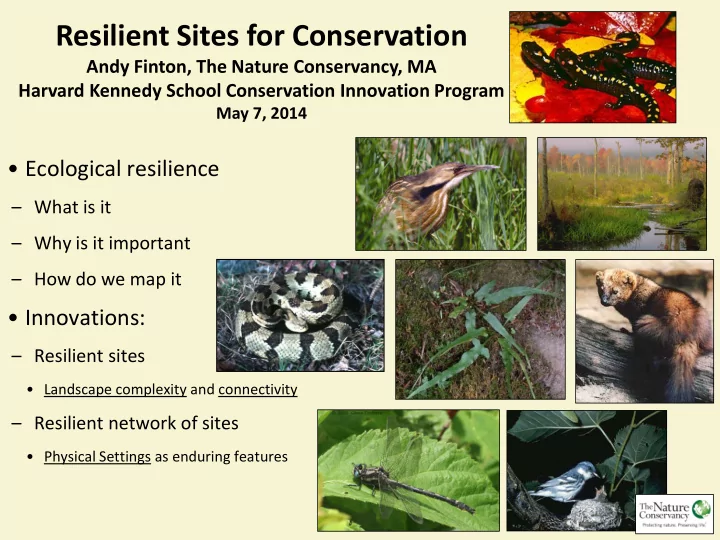

Resilient Sites for Conservation Andy Finton, The Nature Conservancy, MA Harvard Kennedy School Conservation Innovation Program May 7, 2014 • Ecological resilience – What is it – Why is it important – How do we map it • Innovations: – Resilient sites • Landscape complexity and connectivity – Resilient network of sites • Physical Settings as enduring features
Tornado, 2011, MA Ice Storm, 2009, MA Berkshire Eagle Hurricane Irene, 2011, VT Current Predicted Range Parameter (1961-1990) of Change by 2100 Ave. Temperature ( o C) 7.8 10 to 13 Annual Precipitation (cm) 102.9 108 to 117 Sea level rise (cm) 8 21 to 201 Streamflow-spring peak 84.5 72 to 80 flow (days) Droughts lasting 1-3 12.61 16 to 23 months (#/30 yrs) Snow Days/Month (days) 5.2 1 to 4 Length of growing season 184 196 to 227 (days)
Resilience: The ability to recover from disturbance Highly Resilient Sites • Large capacity to adapt - dynamic • Many options and alternatives • Sustain function and diversity
Resilient Sites for Conservation • 2012 TNC Eastern Division – Mark Anderson: Dir. of Conservation Science – Melissa Clark: GIS Analyst • Web site – Reports, data https://www.conservationgateway.org http://nature.ly/NEresilience
Factors that increase site resilience: Buffers species from climate impact Landscape Complexity • How many landforms are available from each point (“microclimates”) Landscape Connectivity (Permeability) • How connected are the lands at each point
Landscape Complexity • Landforms control the distribution of moisture, nutrients and climatic effects • Microclimates = More Variety = more options for species N N Hot - Dry Cool- Moist How many landforms in a given area Mt. Mansfield Mt. Mansfield Landforms Landforms
Landscape Complexity Scores for every cell* in the region *1,000 acre hexagon cells Green = Above average Yellow = Average, Brown = Below average
Landscape Connectivity (Permeability) = The degree to which the landscape allows for species movement (& other natural processes) Highly Permeable Landscapes Provide many options and alternatives Impermeable Landscapes Provide few options Developed by Brad Compton: UMASS CAPS/Landscape Ecology
Connectivity (Permeability) Green = Above average Yellow = Average, Brown = Below average
Estimating Resilience Sites that are resilience to climate change Resilience = Complexity + Connectivity Green = Above average Yellow = Average, Brown = Below average
Resilient Network : Conserving the Stage (Arena) Teams/Arenas = Enduring Features • Players are important, but change over time Network (league) remains resilient • Each team dynamic, with unique contribution
Resilient Network: Conserving the Stage (Arena) • Physical Settings = Geology & Elevation – Enduring features / drivers of diversity / arenas of evolution Low elevation sand – Species matter, but change over time Mid-elevation limestone 30 Settings: Defined by Geology & Elevation Evaluate resilience one setting at a time High elevation sandstone
Scores for the Entire Setting Evaluate resilience one setting at a time Coarse Sand at Very Low Elevations
Sites that are resilient to climate change and represent the full diversity of the region Resilience = Complexity + Connectivity within each setting
MA “Downscaled” Resilience Scores Jessica Dyson, MA TNC GIS Manager • Settings based on MA data • Scaled to MA Resilience = Average of Landscape • 90 meter data Complexity and Connectivity within each physical setting
Climate Change Applications • State Agencies – Land protection and management priorities – Grant criterion – State Wildlife Action Plans? • Land Trusts – Land protection and management priorities – Grant applications “Health is the capacity of the land for self- renewal. Conservation is our effort to understand and preserve this capacity.” Aldo Leopold 1949
Recommend
More recommend